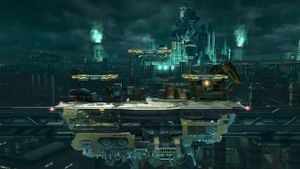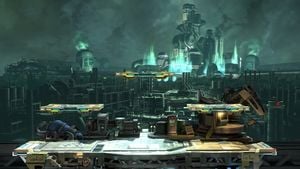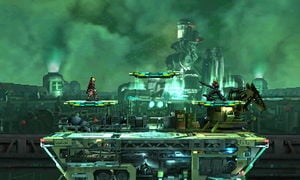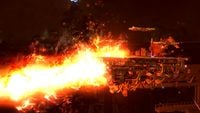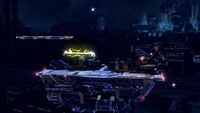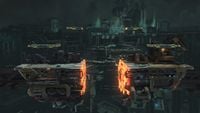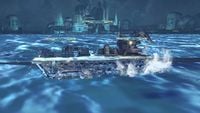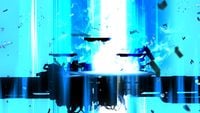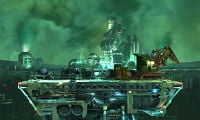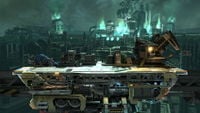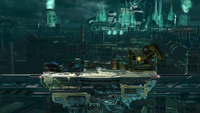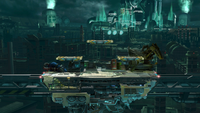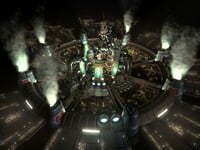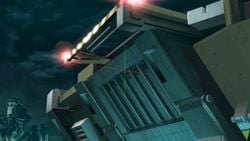Midgar: Difference between revisions
(→Trivia) |
m (Text replacement - "class=("?)invert\b([^-])" to "class=$1invert-dark$2") |
||
| (231 intermediate revisions by more than 100 users not shown) | |||
| Line 1: | Line 1: | ||
{{ArticleIcons|ssb4=y | {{ArticleIcons|ssb4=y|ultimate=y}} | ||
{{Infobox Stage | {{Infobox Stage | ||
| | |subtitle = ''{{iw|wikipedia|Final Fantasy VII}}'' | ||
|name | |name = Midgar | ||
|image | |image = {{tabber|title1=Ultimate|content1=[[File:SSBU-Midgar.jpg|300px]]|title2=Wii U|content2=[[File:Midgar.jpg|300px]]|title3=3DS|content3=[[File:Midgar 3DS.jpg|300px]]}} | ||
| | |caption = [[File:FinalFantasySymbol.svg|50px|class=invert-dark]]<br>Midgar as it appears in ''Smash''. | ||
|universe | |universe = {{uv|Final Fantasy}} | ||
|games = ''[[SSB4]]''<br>''[[Ultimate]]'' | |||
|games | |availability = [[DLC|Downloadable]] (''SSB4'')<br>[[Starter stage|Starter]] (''Ultimate'') | ||
|availability = [[DLC|Downloadable]] | |cratetype = Normal | ||
|cratetype | |maxplayers = 4 (3DS)<br>[[8-Player Smash|8]] (Wii U and ''Ultimate'') | ||
|maxplayers | |for3dsmusic = Main: ''{{SSB4MusicLink|Final Fantasy|Let the Battles Begin!}}''<br>Alternate: ''{{SSB4MusicLink|Final Fantasy|Fight On!}}'' | ||
| | |forwiiumusic = ''{{SSB4MusicLink|Final Fantasy|Let the Battles Begin!}}''<br>''{{SSB4MusicLink|Final Fantasy|Fight On!}} | ||
|ultimatemusic = [[List of SSBU Music (Final Fantasy series)|''Final Fantasy'' series music]]<br>Main: ''{{SSBUMusicLink|Final Fantasy|Let the Battles Begin!}}''<br>Alternate: ''{{SSBUMusicLink|Final Fantasy|Fight On!}} | |||
|ssb4singles = Counterpick (Ω form only) | |||
|ssb4doubles = Banned | |||
|ultimatesingles= Banned | |||
|ultimatedoubles= Banned | |||
|interwiki = wikipedia | |||
|interwikiname = Wikipedia | |||
|interwikipage = Midgar | |||
}} | }} | ||
'''Midgar''' ({{ja|ミッドガル|Middogaru}}, ''Midgar'') is a {{uv|Final Fantasy}} stage in ''[[Super Smash Bros. 4]]'' which is available as [[downloadable content]], as part of a set with {{SSB4|Cloud}}. | {{cquote|''Grab the Summon Materia to call forth powerful beings. If a Summon knocks out a fighter, the point is awarded to whoever grabbed the Summon Materia, so make sure it's you!''|cite=[https://www.smashbros.com/en_US/blog/ Super Smash Blog]|source=[[Super Smash Bros. Ultimate Official Site]]}} | ||
'''Midgar''' ({{ja|ミッドガル|Middogaru}}, ''Midgar'') is a {{uv|Final Fantasy}} stage in ''[[Super Smash Bros. 4]]'' which is available as [[downloadable content]] on December 15th, 2015, as part of a set with {{SSB4|Cloud}}. The stage returns in ''[[Super Smash Bros. Ultimate]]''. In ''Ultimate'', {{SSBU|Cloud}} is fought here for his unlock battle. | |||
==Stage | ==Stage overview== | ||
The basic layout of the stage consists, like {{SSB4|Battlefield}}, of a main platform with three overhanging soft platforms in a triangle formation; however the stage is slightly larger. | The basic layout of the stage consists, like {{SSB4|Battlefield}}, of a main platform with three overhanging soft platforms in a triangle formation; however, the stage is slightly larger. | ||
Summon Materia occasionally | Summon Materia occasionally float around the stage and stops in a random location with a flash. When a character touches it they are surrounded by magical symbols, a monster is summoned which unleashes an attack with greatly disruptive effects. The summoner is immune to any attack by the summon. | ||
===Ifrit=== | |||
[[File:Ifrit uses Hellfire.jpg|thumb|left|200px|Ifrit's Hellfire.]] | |||
'''[[Ifrit]]''' uses [https://finalfantasy.fandom.com/wiki/Hellfire_(ability) Hellfire] (called '''Inferno''' by [[Masahiro Sakurai]] during the [[Final Video Presentation]]). A huge flame erupts randomly either under the middle of the stage (raising it), under one of its sides (heavily tilting it to the side), or from one of the lateral [[blast line]]s (pushing the stage towards the other lateral blast line). Contact with the main body of the flame deals 26%, while contact with its weaker parts deals 1% with no knockback. Unlike the rest of the summons, Ifrit's design comes from ''{{iw|wikipedia|Final Fantasy VIII}}'' rather than ''Final Fantasy VII''. | |||
{{clrl}} | |||
===Ramuh=== | |||
[[File:Ramuh Judgment Bolt.jpg|thumb|left|200px|Ramuh's Judgment Bolt.]] | |||
'''[[Ramuh]]''' uses [https://finalfantasy.fandom.com/wiki/Judgment_Bolt Judgment Bolt]. The three floating platforms are electrified and their arrangement changes to another random one. The three platforms then, one by one, randomly glow and get electrified again. After all three have undergone this process they return to their original position. Landing on an electrified platform [[paralyze]]s fighters and deals continuous damage (up to 21%) before launching them; simply passing through them deals damage but will not paralyze. | |||
{{clrl}} | |||
===Odin=== | |||
[[File:Odin Midgar split.jpg|thumb|left|200px|The stage split in half by Odin's attack.]] | |||
'''[[Odin]]''': uses [https://finalfantasy.fandom.com/wiki/Zantetsuken_(ability) Zantetsuken] (called '''Steel-Bladed Sword''' in ''Final Fantasy VII''). Odin slices through the stage with his sword, splitting the main platform and the top floating platform in half. Characters hit by this attack receive 100% damage, and in most cases are [[KO]]'d. In ''Ultimate'', this attack triggers a [[Special Zoom]]. While the stage is split, its inner ledges can be grabbed. The stage pulls itself back together after a while, [[crush]]ing any character, summoner included, caught between the two halves or hanging from the inner ledges. | |||
{{clrl}} | |||
===Leviathan=== | |||
[[File:Leviathan uses Tsunami.jpg|thumb|left|200px|The stage flooded by Leviathan's attack.]] | |||
'''[[Leviathan]]''' uses [https://finalfantasy.fandom.com/wiki/Tsunami_(ability) Tidal Wave]. The entire arena is flooded, making the main platform surf across a huge body of water. A strong current pushes swimming characters to the left; getting slammed into the right side of the stage deals 9% damage or, if the character has 100% or more damage, an [[instant KO]]. The summoner is susceptible to the current and the slam damage, but not to the instant KO. If a player happens to have [[invincibility]] and enters the water on the right side of the stage, the player may be carried away by the current when it subsides or pushed under the stage to the left side due to not slamming into it.<ref>{{YouTube|vKU_BIO86Vk|t=30}}</ref> Fighters who enter the water under the effects of the [[Super Mushroom]] are trapped in the water (if on the right side) due to the low knockback and potentially KOed. This feature is not present in ''Super Smash Bros. for Nintendo 3DS'', due to the removal of swimming in said game. | |||
{{clr}} | |||
===Bahamut=== | |||
[[File:Bahamut ZERO Teraflare.jpg|thumb|left|200px|Bahamut ZERO's Teraflare.]] | |||
'''[[Bahamut ZERO]]''': Attacks with a devastating [https://finalfantasy.fandom.com/wiki/Teraflare Teraflare], which destroys the city in the background and creates a damaging pillar of light covering about 1/3 of the stage. Getting caught in the beam deals continuous damage, up to 39%. | |||
{{clrl}} | |||
Any opponent [[KO]]'d by a monster's attack counts as a KO on behalf of the summoner. | |||
==Ω | In [[8-Player Smash]] mode, no summoned monsters appear if there are five or more players. If the game is paused in [[Training Mode]], all summon effects are paused but the rest of the action keeps going. | ||
In both versions of ''[[Super Smash Bros. 4]]'', in Training Mode, if the player summons a [[Smash Ball]], the Summon Materia or the summons Leviathan and Ifrit will go away. | |||
===Ω forms and Battlefield form=== | |||
In ''Super Smash Bros. 4'', the [[Ω form]] removes the soft platforms and Summon Materia. | |||
In ''Super Smash Bros. Ultimate'', the Ω form is identical to ''SSB4''{{'}}s Ω form, and the Battlefield form is identical to the normal form; however, they are slightly resized and reshaped to match {{SSBU|Final Destination}} and {{SSBU|Battlefield}}, respectively. | |||
<gallery widths=200px> | <gallery widths=200px> | ||
Midgar Omega 3DS.jpg | Midgar Omega 3DS.jpg|Ω form in ''Super Smash Bros. for Nintendo 3DS''. | ||
Midgar Omega.JPG|Ω form in ''Super Smash Bros. for Wii U''. | |||
SSBU-MidgarOmega.png|Ω form in ''Super Smash Bros. Ultimate''. | |||
SSBU-MidgarBattlefield.png|Battlefield form in ''Super Smash Bros. Ultimate''. | |||
</gallery> | </gallery> | ||
===Hazards Off=== | |||
With hazards off in ''Ultimate'', no Summon Materia ever appears, leaving the stage in its Battlefield-shaped form. | |||
==Origin== | ==Origin== | ||
[[File:Ff7-midgar.jpg|thumb | [[File:Ff7-midgar.jpg|thumb|Midgar as it appears in ''Final Fantasy VII''.]] | ||
Midgar is | Midgar is the first area visited in ''{{s|wikipedia|Final Fantasy VII}}'' and is where much of the game's beginning takes place. Midgar is the capital city and power base of the Shinra Electric Power Company, who built it. The city is divided up into nine sectors. This stage appears to take place on Midgar's top plates, above the ground-level slums that were commonly explored in ''Final Fantasy VII''. | ||
The Shinra Building, one of the most iconic locations in ''Final Fantasy VII'', is visible in the background. A prominent dungeon within the game, it is the headquarters for the Shinra company which plays a central role in ''Final Fantasy VII'''s storyline. The building is where [[Aerith Gainsborough]] is imprisoned after her capture by the Turks during the destruction of Sector 7. Cloud, [[Barret Wallace]] and [[Tifa Lockhart]] infiltrate the building in order to rescue Aerith, and meet Red XIII, a sentient animal from Cosmo Canyon. The party is recaptured, but later freed, following a trail of blood to discover that Cloud's nemesis [[Sephiroth]] is still alive and has murdered President Shinra. After Sephiroth summons Meteor, a cannon known as the Sister Ray is attached to the building and is powered by the six remaining Mako Reactors. Cloud's party returns to Midgar at this time to stop Professor Hojo, who has captured the Sister Ray and intends to use it to empower Sephiroth. | |||
Midgar is also seen in other media in the ''Compilation of Final Fantasy VII''. In the film ''Final Fantasy VII: Advent Children'', Midgar is mostly left in ruins as a result of Meteor's effects. In its stead, a city called Edge is built, where most of the movie's events take place, such as the outburst of the disease known as Geostigma. Cloud later fights Kadaj, and later Sephiroth, in the ruins of the Shinra Building. The ruins of Midgar are visited again in ''Dirge of Cerberus'', where Vincent Valentine fights off the organization known as Deepground and the Omega Weapon, with a climatic confrontation against Weiss, the leader of Deepground, in the former President's Office. | |||
Summons are a recurring element in the ''Final Fantasy'' series since their introduction in ''{{iw|wikipedia|Final Fantasy III}}''. They are powerful creatures that can be summoned into battle to attack enemies or support the party. In ''Final Fantasy VII'', they can be summoned by equipping specific Materia: all the summons appearing on this stage are also available in ''Final Fantasy VII''. | |||
<gallery> | |||
Summon Bahamut ZERO FF7.gif|Bahamut ZERO in ''Final Fantasy VII''. | |||
Ifrit Summon FF7.gif|Ifrit in ''Final Fantasy VII''. | |||
FF7 Summon Odin.gif|Odin in ''Final Fantasy VII''. | |||
Ramuh Summon FF7.gif|Ramuh in ''Final Fantasy VII''. | |||
<!--Leviathan Summon FF7.gif|Leviathan in ''Final Fantasy VII''.--> | |||
</gallery> | |||
==Tournament legality== | |||
While the Ω form of this stage is allowed, the standard stage is [[banned]] in tournaments, as in ''Smash 4'', it overcentralizes gameplay on collecting Materia to gain an advantage; in addition, the summons themselves are quite powerful and can result in unfair advantages to those who summoned them. In ''Ultimate'', the stage is banned due to the layout being very similar to {{SSBU|Battlefield}}, as with a few other stages. Notably, the main platform has an asymmetrical shape, making recoveries hugging the stage slightly unpredictable, the lower platforms are taller than Battlefield, preventing some attacks from hitting opponents standing on them, and the stage is slightly larger. Because of these characteristics, Midgar is considered less ideal than Battlefield and is almost never used in its place. | |||
==Gallery== | ==Gallery== | ||
===''Super Smash Bros. 4''=== | |||
<gallery> | <gallery> | ||
Midgar.jpg|Midgar in {{forwiiu}}. | |||
Cloud5.jpg|Cloud with Bahamut ZERO. | Cloud5.jpg|Cloud with Bahamut ZERO. | ||
Cloud6.jpg|Cloud, {{SSB4|Wii Fit Trainer}}, and {{SSB4|Lucario}} with a Summon Materia. | |||
Midgar 3DS.jpg|Midgar in {{for3ds}}. | Midgar 3DS.jpg|Midgar in {{for3ds}}. | ||
</gallery> | </gallery> | ||
===''Super Smash Bros. Ultimate''=== | |||
<gallery> | |||
SSBUWebsiteFinalfantasySeriesBG.jpg|Panorama of Midgar from ''Ultimate''. | |||
SSBUWebsiteCloud4.jpg|{{SSBU|Cloud}} charging up his [[Limit Charge|Limit Gauge]] next to Ifrit on the stage. | |||
SSBUWebsiteGreninja4.jpg|{{SSBU|Greninja}} using its [[neutral aerial]] with Leviathan on the stage. | |||
SSBUWebsitePiranhaPlant4.jpg|{{SSBU|Piranha Plant}} on the stage. | |||
SSBUWebsiteZeroMM2.jpg|{{b|Zero|Mega Man}} using Genmu Zero on {{SSBU|Ridley}} on the stage. | |||
SSBUWebsiteSephiroth6.jpg|{{SSBU|Cloud}} in his ''Advent Children'' alternate costume fighting {{SSBU|Sephiroth}} on the stage. | |||
SSBUSoraCloudSephy.jpg|Cloud, Sephiroth and {{SSBU|Sora}} on the stage. | |||
</gallery> | |||
==Names in other languages== | |||
{{langtable | |||
|ja={{ja|ミッドガル|Middogaru}}, ''Midgar'' | |||
|en=Midgar | |||
|fr=Midgar | |||
|es=Midgar | |||
|de=Midgar | |||
|it=Midgar | |||
|nl=Midgar | |||
|ru={{rollover|Мидгар|Midgar|?}} | |||
|ko={{rollover|미드가르|Mideugareu|?}}, ''Midgar'' | |||
|zh={{rollover|米德加|Mǐdéjiā|?}}, ''Midgar'' | |||
|pt=Midgar | |||
}} | |||
==Trivia== | ==Trivia== | ||
*Midgar | [[File:leftledgemidgar.jpeg|thumb|250px|The underside of the left ledge, unmodelled]] | ||
* | *In {{forwiiu}}, Midgar only has two music tracks, both taken directly from ''Final Fantasy VII''. This makes Midgar both the stage with the fewest amount of music tracks and the only one in the game lacking any ''Smash''-exclusive arrangements in its lineup. | ||
* | **In ''Super Smash Bros. Ultimate'', it was tied with [[Flat Zone X]] for the fewest amount of tracks, and shared its lack of arrangements with [[Yggdrasil's Altar]]. Challenger Pack 8 would later on introduce nine new songs for Midgar, four of which are new arrangements. | ||
*In ''for Nintendo 3DS'', whenever a match starts or resets in [[Training Mode]], the characters on the floating platforms will always perform their landing animation, as if they start in midair. This does not occur in ''for Wii U''. | |||
*Midgar is the only stage in ''SSB4'' that can [[crush]]. | |||
*Odin's attack does not appear to use a hitbox, but instead, like [[Psystrike]], it uses a searchbox and generates a hitbox inside any fighters detected by it. Like Psystrike, it is therefore possible for two of these hitboxes to overlap, resulting in fighters being hit by the attack twice on the same frame, for a total of 200% damage, and seemingly one-hit KOing them. | |||
*In [[Stamina mode]], if Odin's attack does not KO, it will deal very little knockback. This is because Stamina mode treats opponents' post-hit percents to be 20%, and the move's knockback is programmed with a minimum final damage of 100% or higher in mind. | |||
*In [[Training Mode]], if the game is paused while a summon is in effect, it will continue its effect indefinitely, continuing to affect other fighters (excluding Odin; instead, if paused upon slashing, the game stays slowed down until unpaused or the camera briefly zooms in on the fighter that he strikes (which doesn't happen if multiple fighters are hit) after they're KOed). Summons such as Ifrit and Bahamut ZERO allow for combos of up to 999 to be registered by the game. A similar exploit can be done on stages like {{SSB4|Mario Circuit}}. | |||
*If {{SSB4|Sonic}} is fighting on Midgar in ''for Wii U'', a graphical glitch will occur wherein his eyes appear to reflect the texture of the stage, turning them gray in color. This occurs even on the [[Ω form]] of the stage. | |||
*Upon downloading Challenger Pack 8 in ''Ultimate'', the new ''Final Fantasy'' songs are added to Midgar's [[My Music]] settings with a default probability of 25% each, matching the default settings for Northern Cave. | |||
*No Spirit Battles that use this stage have hazards enabled. | |||
*In ''Ultimate'', the following [[Assist Trophies]] cannot appear on this stage: [[Waluigi]], [[Skull Kid]], the [[Moon]], [[Midna]], [[Nightmare]], [[Knuckle Joe]], [[Andross]], [[Samurai Goroh]], [[Color TV-Game 15]], [[Devil]], [[Nintendog]], [[Dr. Kawashima]], [[Nikki]] (due to the dark background obscuring her drawings), [[Squid Sisters]], [[Ghosts]] and [[Shadow the Hedgehog]]. Additionally, [[Lunala]] cannot be summoned from a [[Poké Ball]] on this stage. | |||
==External links== | |||
*Article on the [http://finalfantasy.wikia.com/wiki/Midgar Final Fantasy Wiki] | |||
==References== | ==References== | ||
{{reflist}} | {{reflist}} | ||
{{SSB4Stages}} | {{SSB4Stages}} | ||
{{SSBUStages}} | |||
{{Final Fantasy universe}} | {{Final Fantasy universe}} | ||
[[Category:Stages (SSB4-Wii U)]] | |||
[[Category:Stages (SSB4-3DS)]] | |||
[[Category:Downloadable content]] | [[Category:Downloadable content]] | ||
[[Category:Past stages]] | |||
[[Category:Square Enix]] | |||
[[es:Midgar]] | |||
Latest revision as of 13:30, May 20, 2024
| Final Fantasy VII Midgar | |
|---|---|
 Midgar as it appears in Smash. | |
| Universe | Final Fantasy |
| Appears in | SSB4 Ultimate |
| Availability | Downloadable (SSB4) Starter (Ultimate) |
| Crate type | Normal |
| Maximum players | 4 (3DS) 8 (Wii U and Ultimate) |
| Article on Wikipedia | Midgar |
| “ | Grab the Summon Materia to call forth powerful beings. If a Summon knocks out a fighter, the point is awarded to whoever grabbed the Summon Materia, so make sure it's you! | ” |
| —Super Smash Blog, Super Smash Bros. Ultimate Official Site | ||
Midgar (ミッドガル, Midgar) is a Final Fantasy stage in Super Smash Bros. 4 which is available as downloadable content on December 15th, 2015, as part of a set with Cloud. The stage returns in Super Smash Bros. Ultimate. In Ultimate, Cloud is fought here for his unlock battle.
Stage overview[edit]
The basic layout of the stage consists, like Battlefield, of a main platform with three overhanging soft platforms in a triangle formation; however, the stage is slightly larger.
Summon Materia occasionally float around the stage and stops in a random location with a flash. When a character touches it they are surrounded by magical symbols, a monster is summoned which unleashes an attack with greatly disruptive effects. The summoner is immune to any attack by the summon.
Ifrit[edit]
Ifrit uses Hellfire (called Inferno by Masahiro Sakurai during the Final Video Presentation). A huge flame erupts randomly either under the middle of the stage (raising it), under one of its sides (heavily tilting it to the side), or from one of the lateral blast lines (pushing the stage towards the other lateral blast line). Contact with the main body of the flame deals 26%, while contact with its weaker parts deals 1% with no knockback. Unlike the rest of the summons, Ifrit's design comes from Final Fantasy VIII rather than Final Fantasy VII.
Ramuh[edit]
Ramuh uses Judgment Bolt. The three floating platforms are electrified and their arrangement changes to another random one. The three platforms then, one by one, randomly glow and get electrified again. After all three have undergone this process they return to their original position. Landing on an electrified platform paralyzes fighters and deals continuous damage (up to 21%) before launching them; simply passing through them deals damage but will not paralyze.
Odin[edit]
Odin: uses Zantetsuken (called Steel-Bladed Sword in Final Fantasy VII). Odin slices through the stage with his sword, splitting the main platform and the top floating platform in half. Characters hit by this attack receive 100% damage, and in most cases are KO'd. In Ultimate, this attack triggers a Special Zoom. While the stage is split, its inner ledges can be grabbed. The stage pulls itself back together after a while, crushing any character, summoner included, caught between the two halves or hanging from the inner ledges.
Leviathan[edit]
Leviathan uses Tidal Wave. The entire arena is flooded, making the main platform surf across a huge body of water. A strong current pushes swimming characters to the left; getting slammed into the right side of the stage deals 9% damage or, if the character has 100% or more damage, an instant KO. The summoner is susceptible to the current and the slam damage, but not to the instant KO. If a player happens to have invincibility and enters the water on the right side of the stage, the player may be carried away by the current when it subsides or pushed under the stage to the left side due to not slamming into it.[1] Fighters who enter the water under the effects of the Super Mushroom are trapped in the water (if on the right side) due to the low knockback and potentially KOed. This feature is not present in Super Smash Bros. for Nintendo 3DS, due to the removal of swimming in said game.
Bahamut[edit]
Bahamut ZERO: Attacks with a devastating Teraflare, which destroys the city in the background and creates a damaging pillar of light covering about 1/3 of the stage. Getting caught in the beam deals continuous damage, up to 39%.
Any opponent KO'd by a monster's attack counts as a KO on behalf of the summoner.
In 8-Player Smash mode, no summoned monsters appear if there are five or more players. If the game is paused in Training Mode, all summon effects are paused but the rest of the action keeps going.
In both versions of Super Smash Bros. 4, in Training Mode, if the player summons a Smash Ball, the Summon Materia or the summons Leviathan and Ifrit will go away.
Ω forms and Battlefield form[edit]
In Super Smash Bros. 4, the Ω form removes the soft platforms and Summon Materia.
In Super Smash Bros. Ultimate, the Ω form is identical to SSB4's Ω form, and the Battlefield form is identical to the normal form; however, they are slightly resized and reshaped to match Final Destination and Battlefield, respectively.
Hazards Off[edit]
With hazards off in Ultimate, no Summon Materia ever appears, leaving the stage in its Battlefield-shaped form.
Origin[edit]
Midgar is the first area visited in Final Fantasy VII and is where much of the game's beginning takes place. Midgar is the capital city and power base of the Shinra Electric Power Company, who built it. The city is divided up into nine sectors. This stage appears to take place on Midgar's top plates, above the ground-level slums that were commonly explored in Final Fantasy VII.
The Shinra Building, one of the most iconic locations in Final Fantasy VII, is visible in the background. A prominent dungeon within the game, it is the headquarters for the Shinra company which plays a central role in Final Fantasy VII's storyline. The building is where Aerith Gainsborough is imprisoned after her capture by the Turks during the destruction of Sector 7. Cloud, Barret Wallace and Tifa Lockhart infiltrate the building in order to rescue Aerith, and meet Red XIII, a sentient animal from Cosmo Canyon. The party is recaptured, but later freed, following a trail of blood to discover that Cloud's nemesis Sephiroth is still alive and has murdered President Shinra. After Sephiroth summons Meteor, a cannon known as the Sister Ray is attached to the building and is powered by the six remaining Mako Reactors. Cloud's party returns to Midgar at this time to stop Professor Hojo, who has captured the Sister Ray and intends to use it to empower Sephiroth.
Midgar is also seen in other media in the Compilation of Final Fantasy VII. In the film Final Fantasy VII: Advent Children, Midgar is mostly left in ruins as a result of Meteor's effects. In its stead, a city called Edge is built, where most of the movie's events take place, such as the outburst of the disease known as Geostigma. Cloud later fights Kadaj, and later Sephiroth, in the ruins of the Shinra Building. The ruins of Midgar are visited again in Dirge of Cerberus, where Vincent Valentine fights off the organization known as Deepground and the Omega Weapon, with a climatic confrontation against Weiss, the leader of Deepground, in the former President's Office.
Summons are a recurring element in the Final Fantasy series since their introduction in Final Fantasy III. They are powerful creatures that can be summoned into battle to attack enemies or support the party. In Final Fantasy VII, they can be summoned by equipping specific Materia: all the summons appearing on this stage are also available in Final Fantasy VII.
Tournament legality[edit]
While the Ω form of this stage is allowed, the standard stage is banned in tournaments, as in Smash 4, it overcentralizes gameplay on collecting Materia to gain an advantage; in addition, the summons themselves are quite powerful and can result in unfair advantages to those who summoned them. In Ultimate, the stage is banned due to the layout being very similar to Battlefield, as with a few other stages. Notably, the main platform has an asymmetrical shape, making recoveries hugging the stage slightly unpredictable, the lower platforms are taller than Battlefield, preventing some attacks from hitting opponents standing on them, and the stage is slightly larger. Because of these characteristics, Midgar is considered less ideal than Battlefield and is almost never used in its place.
Gallery[edit]
Super Smash Bros. 4[edit]
Midgar in Super Smash Bros. for Wii U.
Cloud, Wii Fit Trainer, and Lucario with a Summon Materia.
Midgar in Super Smash Bros. for Nintendo 3DS.
Super Smash Bros. Ultimate[edit]
Cloud charging up his Limit Gauge next to Ifrit on the stage.
Greninja using its neutral aerial with Leviathan on the stage.
Piranha Plant on the stage.
Cloud, Sephiroth and Sora on the stage.
Names in other languages[edit]
| Language | Name |
|---|---|
| ミッドガル, Midgar | |
| Midgar | |
| Midgar | |
| Midgar | |
| Midgar | |
| Midgar | |
| 米德加, Midgar | |
| 미드가르, Midgar | |
| Midgar | |
| Мидгар | |
| Midgar |
Trivia[edit]
- In Super Smash Bros. for Wii U, Midgar only has two music tracks, both taken directly from Final Fantasy VII. This makes Midgar both the stage with the fewest amount of music tracks and the only one in the game lacking any Smash-exclusive arrangements in its lineup.
- In Super Smash Bros. Ultimate, it was tied with Flat Zone X for the fewest amount of tracks, and shared its lack of arrangements with Yggdrasil's Altar. Challenger Pack 8 would later on introduce nine new songs for Midgar, four of which are new arrangements.
- In for Nintendo 3DS, whenever a match starts or resets in Training Mode, the characters on the floating platforms will always perform their landing animation, as if they start in midair. This does not occur in for Wii U.
- Midgar is the only stage in SSB4 that can crush.
- Odin's attack does not appear to use a hitbox, but instead, like Psystrike, it uses a searchbox and generates a hitbox inside any fighters detected by it. Like Psystrike, it is therefore possible for two of these hitboxes to overlap, resulting in fighters being hit by the attack twice on the same frame, for a total of 200% damage, and seemingly one-hit KOing them.
- In Stamina mode, if Odin's attack does not KO, it will deal very little knockback. This is because Stamina mode treats opponents' post-hit percents to be 20%, and the move's knockback is programmed with a minimum final damage of 100% or higher in mind.
- In Training Mode, if the game is paused while a summon is in effect, it will continue its effect indefinitely, continuing to affect other fighters (excluding Odin; instead, if paused upon slashing, the game stays slowed down until unpaused or the camera briefly zooms in on the fighter that he strikes (which doesn't happen if multiple fighters are hit) after they're KOed). Summons such as Ifrit and Bahamut ZERO allow for combos of up to 999 to be registered by the game. A similar exploit can be done on stages like Mario Circuit.
- If Sonic is fighting on Midgar in for Wii U, a graphical glitch will occur wherein his eyes appear to reflect the texture of the stage, turning them gray in color. This occurs even on the Ω form of the stage.
- Upon downloading Challenger Pack 8 in Ultimate, the new Final Fantasy songs are added to Midgar's My Music settings with a default probability of 25% each, matching the default settings for Northern Cave.
- No Spirit Battles that use this stage have hazards enabled.
- In Ultimate, the following Assist Trophies cannot appear on this stage: Waluigi, Skull Kid, the Moon, Midna, Nightmare, Knuckle Joe, Andross, Samurai Goroh, Color TV-Game 15, Devil, Nintendog, Dr. Kawashima, Nikki (due to the dark background obscuring her drawings), Squid Sisters, Ghosts and Shadow the Hedgehog. Additionally, Lunala cannot be summoned from a Poké Ball on this stage.
External links[edit]
- Article on the Final Fantasy Wiki
References[edit]
|
| |
|---|---|
| Fighters | Cloud (SSB4 · SSBU) · Sephiroth (SSBU) |
| Stages | Midgar · Northern Cave |
| Other | Aerith Gainsborough · Bahamut ZERO · Barret Wallace · Chocobo · Ifrit · Leviathan · Odin · Ramuh · Tifa Lockhart |
| Trophies & Spirits | Trophies · Spirits |
| Music | SSB4 · Ultimate |
| Related universe | Kingdom Hearts |
